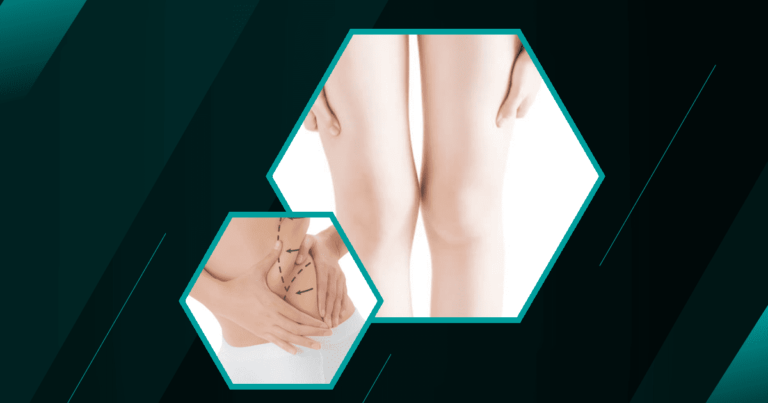Liposuction can offer amazing body-sculpting results—but like any surgery, things don’t always go as planned. If you’re dealing with uneven results, lumps, pain, or strange swelling, you might be wondering if your liposuction went wrong. Don’t panic—while complications can happen, many of them are treatable.
In this article, we’ll break down the signs that something’s not right, common causes behind botched liposuction, and the solutions available—from touch-up procedures to recovery tips—so you know what steps to take toward feeling better and getting the results you expected.
Common Signs of Botched Liposuction & How to Avoid Them
Liposuction is a popular cosmetic procedure aimed at removing excess fat to enhance body contours. However, when liposuction goes wrong, it can lead to a range of complications and unsatisfactory results. Understanding the signs and causes of botched liposuction is crucial for anyone considering this procedure.
Common Signs of Botched Liposuction
Botched liposuction can manifest in various ways, often leaving patients with visible irregularities. Uneven contours and lumps are common signs, resulting from uneven fat removal or poor surgical technique. These irregularities can be distressing and may require corrective procedures to address.
Book A Consultation With Dr Tarek Bayazid
Top-rated Plastic Surgeon For Liposuction in Dubai
Installment Plan Available
Excessive scarring is another indicator of a poorly performed liposuction. While some scarring is expected, excessive or hypertrophic scars can occur due to improper incision techniques or inadequate post-operative care. These scars can be unsightly and may require additional treatments to improve their appearance.
- Uneven contours and lumps
- Excessive scarring
- Asymmetry and disproportionate body shape
Risks Associated with Poorly Performed Liposuction
Liposuction, when not performed correctly, carries several risks. Infections can occur if the surgical environment is not sterile or if post-operative care is neglected. Persistent pain and discomfort are also common, often resulting from nerve damage or excessive tissue trauma during the procedure.
What Causes Liposuction to Go Wrong?
Understanding the causes of liposuction complications is essential for prevention. Several factors can contribute to unsatisfactory outcomes, ranging from surgeon inexperience to patient non-compliance.
Inexperienced Surgeons
One of the primary causes of liposuction gone wrong is the lack of experience and expertise of the surgeon. Inexperienced surgeons may not have the necessary skills to perform the procedure safely and effectively, leading to poor results and increased risk of complications.
Poor Surgical Techniques
Even experienced surgeons can make mistakes if they employ outdated or inappropriate surgical techniques. Poor techniques can result in uneven fat removal, excessive tissue trauma, and other complications that affect the overall outcome of the procedure.
Patient Non-Compliance with Post-Operative Care
Patients play a crucial role in the success of their liposuction procedure. Non-compliance with post-operative care instructions can lead to complications such as infections, delayed healing, and unsatisfactory results. Following the surgeon’s guidelines is essential for a smooth recovery.
- Inexperienced surgeons
- Poor surgical techniques
- Non-compliance with post-operative care
Identifying Bad Liposuction Results
Recognizing the signs of bad liposuction results is the first step in seeking corrective measures. Patients should be aware of the common indicators of unsatisfactory outcomes.
Uneven Contours and Lumps
Uneven contours and lumps are often the most noticeable signs of a botched liposuction. These irregularities can occur when fat is removed unevenly, leaving behind unsightly bulges and depressions.
Excessive Scarring
Excessive scarring can be a result of improper incision techniques or inadequate post-operative care. These scars can be more prominent than expected and may require additional treatments to improve their appearance.
Asymmetry and Disproportionate Body Shape
Asymmetry and disproportionate body shape can occur when liposuction is not performed evenly across the treated areas. This can lead to an unbalanced appearance that may require corrective procedures to address.
- Uneven contours and lumps
- Excessive scarring
- Asymmetry and disproportionate body shape
How to Fix Liposuction Gone Wrong
Corrective measures are available for those who have experienced unsatisfactory liposuction results. These solutions can help improve the appearance and restore confidence.
Corrective Procedures for Botched Liposuction
Corrective procedures, such as revision liposuction or fat grafting, can address issues like uneven contours and asymmetry. These procedures are performed by experienced surgeons who specialize in correcting previous liposuction mistakes.
Non-Surgical Treatments for Minor Issues
For minor issues, non-surgical treatments like laser therapy or ultrasound can help improve skin texture and reduce the appearance of scars. These treatments are less invasive and can be effective for addressing minor irregularities.
Importance of Choosing a Board-Certified Plastic Surgeon
Choosing a board-certified plastic surgeon is crucial for achieving satisfactory results. Board certification ensures that the surgeon has the necessary training and expertise to perform liposuction safely and effectively.
- Corrective procedures for botched liposuction
- Non-surgical treatments for minor issues
- Importance of choosing a board-certified plastic surgeon
Preventing Liposuction Gone Wrong
Prevention is key to avoiding the complications associated with liposuction. By taking certain precautions, patients can minimize the risk of unsatisfactory outcomes.
Researching Qualified Surgeons
Researching and selecting a qualified liposuction surgeon like Dr. Tarek is the first step in preventing liposuction complications. Patients should look for board-certified plastic surgeons with a proven track record of successful procedures.
Understanding the Procedure and Its Limitations
Understanding the limitations of liposuction is essential for setting realistic expectations. Liposuction is not a weight-loss solution but a body contouring procedure, and patients should be aware of what it can and cannot achieve.
Following Pre- and Post-Operative Instructions
Following the surgeon’s pre- and post-operative instructions is crucial for a smooth recovery. Patients should adhere to guidelines regarding activity restrictions, wound care, and follow-up appointments to ensure optimal results.
- Researching qualified surgeons
- Understanding the procedure and its limitations
- Following pre- and post-operative instructions
Legal Aspects of Liposuction Gone Wrong
Understanding the legal aspects of liposuction complications is important for patients who have experienced unsatisfactory outcomes. Knowing your rights and the steps to take can help in seeking compensation or corrective measures.
Patient Rights in Cases of Medical Malpractice
Patients have rights in cases of medical malpractice, including the right to seek compensation for damages. It is important to consult with a legal professional to understand your options and the steps to take.
Importance of Documentation and Evidence
Documentation and evidence are crucial in pursuing a legal claim for liposuction complications. Patients should keep detailed records of their procedure, including pre- and post-operative instructions, communications with the surgeon, and any complications experienced.
- Patient rights in cases of medical malpractice
- Statute of limitations for liposuction claims
- Importance of documentation and evidence
Emotional Impact of Liposuction Gone Wrong
The emotional impact of a botched liposuction can be significant, affecting a patient’s self-esteem and mental well-being. Addressing these emotional challenges is an important part of the recovery process.
Dealing with Disappointment and Regret
Dealing with disappointment and regret is common for patients who have experienced unsatisfactory liposuction results. It is important to acknowledge these feelings and seek support from friends, family, or mental health professionals.
Seeking Support and Counseling
Seeking support and counseling can help patients cope with the emotional impact of a botched procedure. Professional counseling can provide valuable tools for managing stress and building resilience.
- Dealing with disappointment and regret
- Seeking support and counseling
- Building body confidence after a botched procedure
Final Thoughts
Liposuction can offer great results—but when things go wrong, it’s important to recognize the signs early. Uneven results, infection, or prolonged pain shouldn’t be ignored. Whether the issue stems from poor technique or aftercare, timely intervention and professional guidance can help. Your safety and confidence matter—don’t hesitate to seek solutions if something feels off.
FAQs
What are the signs of a botched liposuction?
Visible irregularities and deformities are common signs of a botched liposuction. These can include uneven contours, lumps, and asymmetry. Persistent pain and discomfort may also indicate complications, often resulting from nerve damage or excessive tissue trauma. Infections and prolonged healing are additional signs that the procedure may not have been performed correctly.
Can bad liposuction be fixed?
Yes, bad liposuction can often be fixed through corrective procedures. Revision liposuction or fat grafting can address issues like uneven contours and asymmetry. The timeline for revision surgery varies, but it is typically recommended to wait several months after the initial procedure to allow for healing. Patients should have realistic expectations for corrective treatments, as they may not completely reverse the original outcome.
How long does it take to see bad results from liposuction?
Immediate complications from liposuction can be apparent shortly after the procedure, such as excessive swelling or infection. However, long-term issues like uneven contours or asymmetry may take weeks or months to become fully visible. It is important to consult a surgeon if unsatisfactory outcomes are noticed, as early intervention can improve the chances of successful correction.








